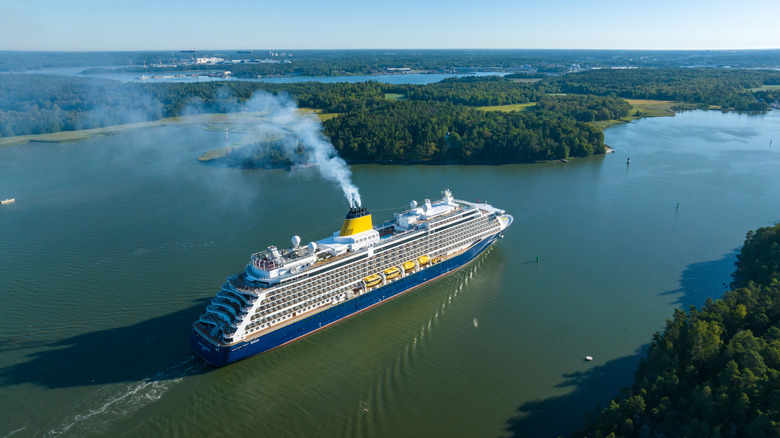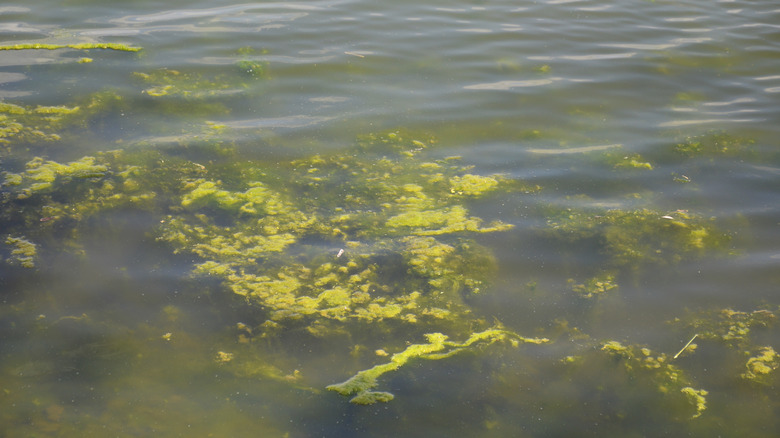Here's Where All The Passengers' Nasty Waste, Trash, And Sewage Really Goes While On A Cruise
Cruises are one of the most popular forms of travel, with over 30 million passengers on the world's seas and oceans each year. These days, the largest cruise ships can house over 6,000 passengers and 2,000 crew members, essentially making them floating cities. All cities, whether on land or sea, produce waste. The difference is that cruise ships don't have access to the same sustainable waste disposal infrastructure as land-based cities. It's this production and disposal of waste that has raised concerns about cruise ships and their impact on environmental sustainability because this waste goes exactly where you might expect: into our oceans.
It's estimated that the cruise industry produces over one billion gallons of waste every year. This sewage typically comprises bilge water (e.g., grease and oil), graywater from showers and kitchens, ballast water, food waste, and black water from toilets and urinals. Some of this waste, such as food and other solids, is incinerated while at sea or processed once back on land. The rest, mostly liquids, are discharged while at sea. Most cruise ships treat the sewage before dumping it, removing harmful pollutants. But there's still no evidence or public reporting of how effective this treatment is at removing all pollution. Some older cruise ships don't even have proper treatment facilities.
All this waste can have a serious impact on the environment. Blackwater pollutants can produce oxygen-depleting algal blooms, killing off entire areas of marine life. Greywater disinfectants and oils can stop marine organisms, like plankton, from completing important processes for their ecosystems. A 2025 study published on the Marine Pollution Bulletin found that treating ballast water actually harms ocean life, causing water acidification that destroys shellfish and reef-building corals. Even bilge water can create slick on the water surface, which can hurt seabirds and marine organisms.
What's being done about passenger waste on cruises?
Back in the late 2000s, many passengers and ocean protection agencies were calling for more cruise companies to implement advanced waste treatment facilities on their ships. This was to stop the dumping of raw, untreated sewage into oceans. Fast forward to 2025, and although most modern cruise ships now have these facilities, there's not enough data on the treatment's efficacy for it to calm the minds of conservation organizations.
Friends of the Earth released a 2024 Cruise Ship Report Card, which scored 21 major cruise lines on their sewage treatment across 243 ships. The highest rating for any cruise line was a C. This score was given to cruise lines that had advanced sewage treatment systems on their ships but were not publicly reporting the systems' performance. Cruise lines with a score below C, such as Carnival, Costa, and MSC, did not have these systems on any of their ships. All the cruise lines also failed the Water Quality Compliance check because, although they were reducing air pollution with exhaust gas scrubbers, they were producing more water pollution with these devices.
Although there are these sanitation devices, as well as sewage laws and regulations and no-discharge zones, a lot of people and organizations don't believe clean cruising is possible yet. While Carnival is updating mobility scooter rules and Norwegian Cruise Line is starting a new policy that allows guests to keep their loyalty status on all its lines, few companies seem interested in focusing on being more environmentally friendly. As a passenger, it's important to take this environmental impact into consideration before booking your next cruise holiday. You could even end up living with your own waste, like on the infamous "Poop Cruise," one of the worst things to ever happen on cruise ships.

